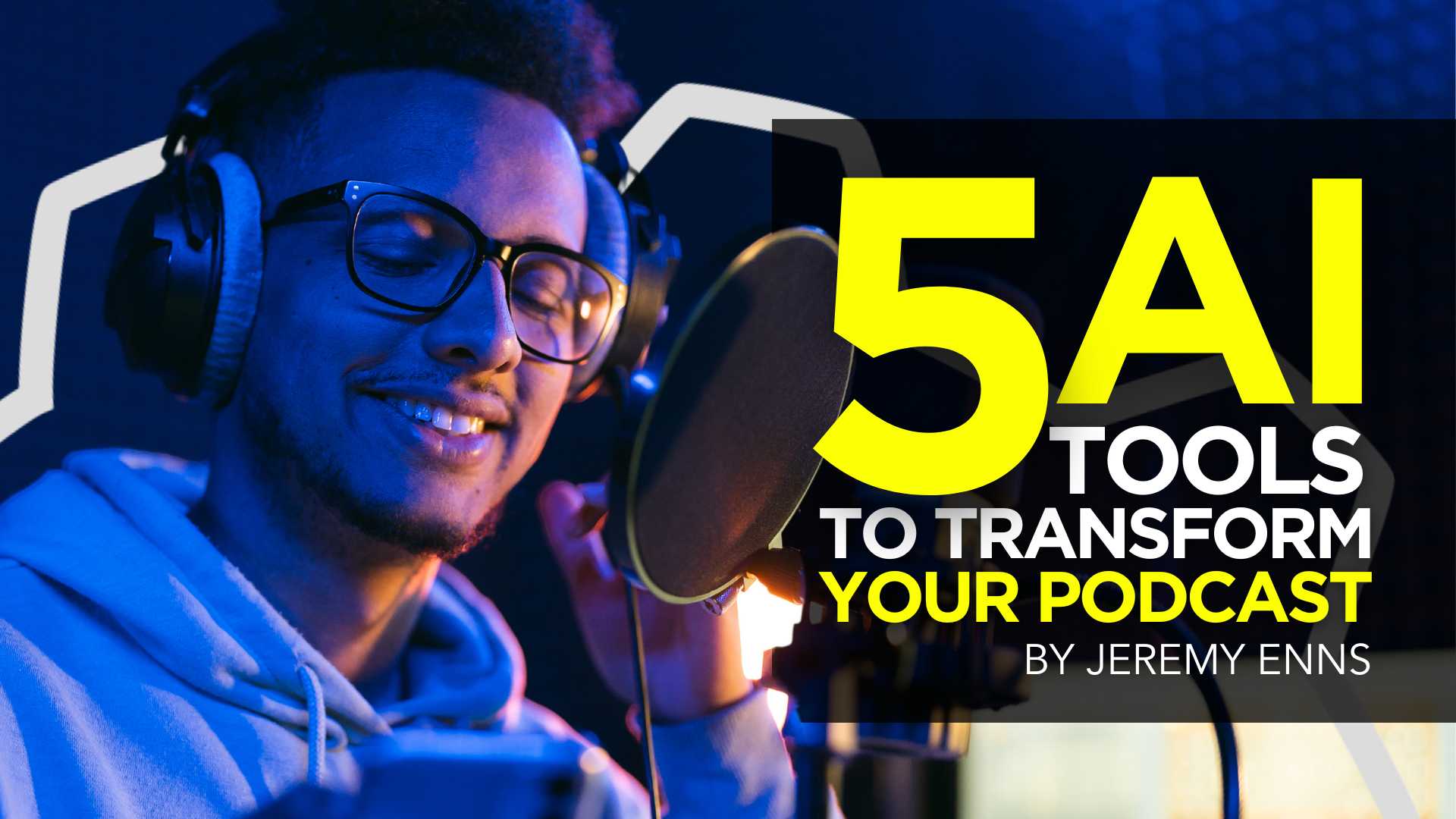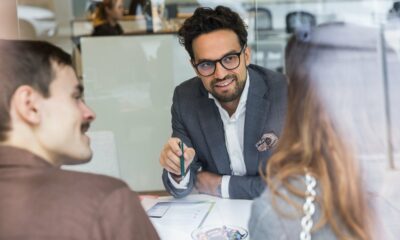MARKETING
5 AI Tools to Transform Your Podcast Production & Marketing Process

After years of speculating about whether the buzz around AI was justified, by now, most of us as marketers and entrepreneurs have accepted that the promise of AI-enabled tools is real.
It’s clear that AI technology will impact (and perhaps radically transform) almost every aspect of our work and lives.
Podcasting is no exception.
And while there are certainly challenges AI will present to us as podcasters, content creators, and marketers, there are also some incredible benefits.
Specifically, those benefits revolve around the ways in which AI will make our jobs easier when it comes to creating, repurposing, and marketing our shows to get them in front of our ideal listeners, and ultimately, clients and customers.
So in this article, we’ll look at 5 AI podcasting tools you can start using today to create a better show and reach more people for less money and in less time.
1. AI-Generated Podcast Show Notes
If you’re like most podcast hosts, writing show notes for each episode is likely one of your least favorite parts of the production process.
Fortunately, a growing number of AI-writing assistants like Capsho have emerged to help take this time-intensive (not to mention boring) task off your hands.
All you have to do is upload your finished audio file and Capsho will automatically write your episode’s show notes, suggest a title, create a transcript, pull out quotes, generate social captions, and even repurpose your episode into a blog post, newsletter, and LinkedIn article.
Keep in mind you’ll still need to do some manual tweaking to polish off the AI-generated, but for many hosts, Capsho, or similar tools like Swell or Podcast Marketing.ai can get you 90% of the way there.
2. AI-Generated Podcast Promotional Assets
One of the best ways to drive awareness of your show is by repurposing it into short-form video.
And while manually combing through your episodes in search of the perfect clip can be a painstaking process, once again, AI has come to the rescue.
If you’re already recording video for your podcast, Vidyo is a nifty tool that automatically identifies, pulls, and captions compelling clips from any video file you upload.
In addition to a number of high-quality, customizable templates, Vidyo also has a nifty feature that automatically cuts between speakers, helping keep your viewers engaged on longer clips.
If you don’t record video for your podcast, not to worry.
Dubb is another podcast repurposing tool that generates AI-created background animations & transcripts from your uploaded audio files to create unique and engaging videos instantly.
3. AI Podcast Post-Production
So far, we’ve explored AI tools to help you repurpose your finished episode recordings. But there are a number of tools designed to make creating a high-quality show easier in the first place.
Descript has been on the scene the longest and has a whole suite of editing features including AI-generated transcript creation, audio clean-up, automatic filler-word removal, and more.

Want to get certified in Content Marketing?
Leverage the tools and channels to predictably and profitably drive awareness, leads, sales, and referrals—EVERYTHING you need to know to become a true master of digital marketing. Click Here
But while Descript certainly has a powerful feature set, it’s far from the only option.
Perhaps the most intriguing new tool is Adobe Podcast.
While it’s currently still in beta, Adobe has released a couple of features for free, including their jaw-dropping Enhance Speech tool, which uses AI to transform almost any recording into an NPR-quality finished product (seriously).
With tools like Enhance Speech, the barriers to entry in terms of recording gear, software, and technical know-how is rapidly dropping, meaning one less layer of friction between your ideas and your audience.
4. AI Voice Generation
One of the most fascinating applications of AI when it comes to podcasting is AI voice generation.
Maybe you’re a writer who would love to turn your blog posts into podcast episodes but doesn’t have the time, for example.
No problem.
With Listnr, you can simply upload your text, choose your voice (currently over 70 languages available with dozens of accent variables in each), and generate an audio version of your article in minutes.
But say you want to make things a bit more personal.
In addition to its post-production and editing tools, Descript’s Overdub feature allows you to train an AI voice model on your own voice.
Once the model has been trained, you can use Overdub to do everything from typing in a replacement word for one you flubbed during the recording to generating new custom audio content based on text.
5. AI Video Alteration
Our final entry into the list might not apply to every podcaster, but it’s no doubt one of the coolest AI tools I’ve come across to date, especially if you record video for your podcast.
When it comes to production quality, there’s no denying that eye contact with the camera is one of the most important factors to consider.
For solo videos, eye contact allows for a more personal, intimate experience for your viewers. For interviews, that depth of connection extends to your guest as well, leading to better interviews, and a better experience for both them and your audience.
The problem (as we’ve all experienced on countless awkward Zoom calls) is that you can’t look at the camera and your guest’s video (or your script) at the same time.
To solve this, most serious video podcasters and YouTubers eventually opt to invest in bulky, often expensive teleprompters.
With NVIDIA’s new Eye Contact tool (a part of their Broadcast app), however, teleprompters might soon become obsolete.
The tool uses AI to seamlessly edit your video feed in real time so your eyes always remain locked on the camera, even while you’re taking notes or reading from a script.
Honestly, it’s kind of mind-blowing.
Unfortunately, Broadcast is only available for Windows right now, though I have no doubt we’ll be seeing more tools like this emerge for other operating systems soon enough.
How Will AI Impact Your Production Workflow?

The AI arms race is well underway, both in terms of the development of new technologies and applications, as well as the adoption of those tools by small businesses, marketers, and creators looking to get a leg up on the competition.
While there are certainly still kinks to be ironed out, it’s clear that AI-enabled tools have emerged as viable options to help us create better content faster and cheaper than we could just a couple of years ago.
If you’re like me, this has you excited.
It means we can spend less time on the menial admin work that doesn’t make use of our unique talents and perspective, and more time on the creative, ideas-driven work that only we can do.
And it’s that work that will ultimately allow us to move our businesses forward.
MARKETING
18 Events and Conferences for Black Entrepreneurs in 2024

Welcome to Breaking the Blueprint — a blog series that dives into the unique business challenges and opportunities of underrepresented business owners and entrepreneurs. Learn how they’ve grown or scaled their businesses, explored entrepreneurial ventures within their companies, or created side hustles, and how their stories can inspire and inform your own success.
It can feel isolating if you’re the only one in the room who looks like you.
MARKETING
IAB Podcast Upfront highlights rebounding audiences and increased innovation


Podcasts are bouncing back from last year’s slowdown with digital audio publishers, tech partners and brands innovating to build deep relationships with listeners.
At the IAB Podcast Upfront in New York this week, hit shows and successful brand placements were lauded. In addition to the excitement generated by stars like Jon Stewart and Charlamagne tha God, the numbers gauging the industry also showed promise.
U.S. podcast revenue is expected to grow 12% to reach $2 billion — up from 5% growth last year — according to a new IAB/PwC study. Podcasts are projected to reach $2.6 billion by 2026.
The growth is fueled by engaging content and the ability to measure its impact. Adtech is stepping in to measure, prove return on spend and manage brand safety in gripping, sometimes contentious, environments.
“As audio continues to evolve and gain traction, you can expect to hear new innovations around data, measurement, attribution and, crucially, about the ability to assess podcasting’s contribution to KPIs in comparison to other channels in the media mix,” said IAB CEO David Cohen, in his opening remarks.
Comedy and sports leading the way
Podcasting’s slowed growth in 2023 was indicative of lower ad budgets overall as advertisers braced for economic headwinds, according to Matt Shapo, director, Media Center for IAB, in his keynote. The drought is largely over. Data from media analytics firm Guideline found podcast gross media spend up 21.7% in Q1 2024 over Q1 2023. Monthly U.S. podcast listeners now number 135 million, averaging 8.3 podcast episodes per week, according to Edison Research.
Comedy overtook sports and news to become the top podcast category, according to the new IAB report, “U.S. Podcast Advertising Revenue Study: 2023 Revenue & 2024-2026 Growth Projects.” Comedy podcasts gained nearly 300 new advertisers in Q4 2023.
Sports defended second place among popular genres in the report. Announcements from the stage largely followed these preferences.
Jon Stewart, who recently returned to “The Daily Show” to host Mondays, announced a new podcast, “The Weekly Show with Jon Stewart,” via video message at the Upfront. The podcast will start next month and is part of Paramount Audio’s roster, which has a strong sports lineup thanks to its association with CBS Sports.
Reaching underserved groups and tastes
IHeartMedia toasted its partnership with radio and TV host Charlamagne tha God. Charlamagne’s The Black Effect is the largest podcast network in the U.S. for and by black creators. Comedian Jess Hilarious spoke about becoming the newest co-host of the long-running “The Breakfast Club” earlier this year, and doing it while pregnant.
The company also announced a new partnership with Hello Sunshine, a media company founded by Oscar-winner Reese Witherspoon. One resulting podcast, “The Bright Side,” is hosted by journalists Danielle Robay and Simone Boyce. The inspiration for the show was to tell positive stories as a counterweight to negativity in the culture.
With such a large population listening to podcasts, advertisers can now benefit from reaching specific groups catered to by fine-tuned creators and topics. As the top U.S. audio network, iHeartMedia touted its reach of 276 million broadcast listeners.
Connecting advertisers with the right audience
Through its acquisition of technology, including audio adtech company Triton Digital in 2021, as well as data partnerships, iHeartMedia claims a targetable audience of 34 million podcast listeners through its podcast network, and a broader audio audience of 226 million for advertisers, using first- and third-party data.
“A more diverse audience is tuning in, creating more opportunities for more genres to reach consumers — from true crime to business to history to science and culture, there is content for everyone,” Cohen said.
The IAB study found that the top individual advertiser categories in 2023 were Arts, Entertainment and Media (14%), Financial Services (13%), CPG (12%) and Retail (11%). The largest segment of advertisers was Other (27%), which means many podcast advertisers have distinct products and services and are looking to connect with similarly personalized content.
Acast, the top global podcast network, founded in Stockholm a decade ago, boasts 125,000 shows and 400 million monthly listeners. The company acquired podcast database Podchaser in 2022 to gain insights on 4.5 million podcasts (at the time) with over 1.7 billion data points.
Measurement and brand safety
Technology is catching up to the sheer volume of content in the digital audio space. Measurement company Adelaide developed its standard unit of attention, the AU, to predict how effective ad placements will be in an “apples to apples” way across channels. This method is used by The Coca-Cola Company, NBA and AB InBev, among other big advertisers.
In a study with National Public Media, which includes NPR radio and popular podcasts like the “Tiny Desk” concert series, Adelaide found that NPR, on average, scored 10% higher than Adelaide’s Podcast AU Benchmarks, correlating to full-funnel outcomes. NPR listeners weren’t just clicking through to advertisers’ sites, they were considering making a purchase.
Advertisers can also get deep insights on ad effectiveness through Wondery’s premium podcasts — the company was acquired by Amazon in 2020. Ads on its podcasts can now be managed through the Amazon DSP, and measurement of purchases resulting from ads will soon be available.
The podcast landscape is growing rapidly, and advertisers are understandably concerned about involving their brands with potentially controversial content. AI company Seekr develops large language models (LLMs) to analyze online content, including the context around what’s being said on a podcast. It offers a civility rating that determines if a podcast mentioning “shootings,” for instance, is speaking responsibly and civilly about the topic. In doing so, Seekr adds a layer of confidence for advertisers who would otherwise pass over an opportunity to reach an engaged audience on a topic that means a lot to them. Seekr recently partnered with ad agency Oxford Road to bring more confidence to clients.
“When we move beyond the top 100 podcasts, it becomes infinitely more challenging for these long tails of podcasts to be discovered and monetized,” said Pat LaCroix, EVP, strategic partnerships at Seekr. “Media has a trust problem. We’re living in a time of content fragmentation, political polarization and misinformation. This is all leading to a complex and challenging environment for brands to navigate, especially in a channel where brand safety tools have been in the infancy stage.”
Dig deeper: 10 top marketing podcasts for 2024
MARKETING
Foundations of Agency Success: Simplifying Operations for Growth


Why do we read books like Traction, Scaling Up, and the E-Myth and still struggle with implementing systems, defining processes, and training people in our agency?
Those are incredibly comprehensive methodologies. And yet digital agencies still suffer from feast or famine months, inconsistent results and timelines on projects, quality control, revisions, and much more. It’s not because they aren’t excellent at what they do. I
t’s not because there isn’t value in their service. It’s often because they haven’t defined the three most important elements of delivery: the how, the when, and the why.
Complicating our operations early on can lead to a ton of failure in implementing them. Business owners overcomplicate their own processes, hesitate to write things down, and then there’s a ton of operational drag in the company.
Couple that with split attention and paper-thin resources and you have yourself an agency that spends most of its time putting out fires, reacting to problems with clients, and generally building a culture of “the Founder/Creative Director/Leader will fix it” mentality.
Before we chat through how truly simple this can all be, let’s first go back to the beginning.
When we start our companies, we’re told to hustle. And hustle hard. We’re coached that it takes a ton of effort to create momentum, close deals, hire people, and manage projects. And that is all true. There is a ton of work that goes into getting a business up and running.


The challenge is that we all adopt this habit of burning the candle at both ends and the middle all for the sake of growing the business. And we bring that habit into the next stage of growth when our business needs… you guessed it… exactly the opposite.
In Mike Michalowitz’s book, Profit First he opens by insisting the reader understand and accept a fundamental truth: our business is a cash-eating monster. The truth is, our business is also a time-eating monster. And it’s only when we realize that as long as we keep feeding it our time and our resources, it’ll gobble everything up leaving you with nothing in your pocket and a ton of confusion around why you can’t grow.
Truth is, financial problems are easy compared to operational problems. Money is everywhere. You can go get a loan or go create more revenue by providing value easily. What’s harder is taking that money and creating systems that produce profitably. Next level is taking that money, creating profit and time freedom.
In my bestselling book, The Sabbatical Method, I teach owners how to fundamentally peel back the time they spend in their company, doing everything, and how it can save owners a lot of money, time, and headaches by professionalizing their operations.
The tough part about being a digital agency owner is that you likely started your business because you were great at something. Building websites, creating Search Engine Optimization strategies, or running paid media campaigns. And then you ended up running a company. Those are two very different things.


How to Get Out of Your Own Way and Create Some Simple Structure for Your Agency…
- Start Working Less
I know this sounds really brash and counterintuitive, but I’ve seen it work wonders for clients and colleagues alike. I often say you can’t see the label from inside the bottle and I’ve found no truer statement when it comes to things like planning, vision, direction, and operations creation.
Owners who stay in the weeds of their business while trying to build the structure are like hunters in the jungle hacking through the brush with a machete, getting nowhere with really sore arms. Instead, define your work day, create those boundaries of involvement, stop working weekends, nights and jumping over people’s heads to solve problems.
It’ll help you get another vantage point on your company and your team can build some autonomy in the meantime.
- Master the Art of Knowledge Transfer
There are two ways to impart knowledge on others: apprenticeship and writing something down. Apprenticeship began as a lifelong relationship and often knowledge was only retained by ONE person who would carry on your method.
Writing things down used to be limited (before the printing press) to whoever held the pages.
We’re fortunate that today, we have many ways of imparting knowledge to our team. And creating this habit early on can save a business from being dependent on any one person who has a bunch of “how” and “when” up in their noggin.
While you’re taking some time to get out of the day-to-day, start writing things down and recording your screen (use a tool like loom.com) while you’re answering questions.


Deposit those teachings into a company knowledge base, a central location for company resources. Some of the most scaleable and sellable companies I’ve ever worked with had this habit down pat.
- Define Your Processes
Lean in. No fancy tool or software is going to save your company. Every team I’ve ever worked with who came to me with a half-built project management tool suffered immensely from not first defining their process. This isn’t easy to do, but it can be simple.
The thing that hangs up most teams to dry is simply making decisions. If you can decide how you do something, when you do it and why it’s happening that way, you’ve already won. I know exactly what you’re thinking: our process changes all the time, per client, per engagement, etc. That’s fine.
Small businesses should be finding better, more efficient ways to do things all the time. Developing your processes and creating a maintenance effort to keep them accurate and updated is going to be a liferaft in choppy seas. You’ll be able to cling to it when the agency gets busy.
“I’m so busy, how can I possibly work less and make time for this?”


You can’t afford not to do this work. Burning the candle at both ends and the middle will catch up eventually and in some form or another. Whether it’s burnout, clients churning out of the company, a team member leaving, some huge, unexpected tax bill.
I’ve heard all the stories and they all suck. It’s easier than ever to start a business and it’s harder than ever to keep one. This work might not be sexy, but it gives us the freedom we craved when we began our companies.
Start small and simple and watch your company become more predictable and your team more efficient.
-

 PPC6 days ago
PPC6 days agoHow the TikTok Algorithm Works in 2024 (+9 Ways to Go Viral)
-

 SEO7 days ago
SEO7 days agoBlog Post Checklist: Check All Prior to Hitting “Publish”
-

 SEO5 days ago
SEO5 days agoHow to Use Keywords for SEO: The Complete Beginner’s Guide
-

 MARKETING6 days ago
MARKETING6 days agoHow To Protect Your People and Brand
-

 SEARCHENGINES7 days ago
SEARCHENGINES7 days agoGoogle Started Enforcing The Site Reputation Abuse Policy
-

 PPC7 days ago
PPC7 days agoHow to Craft Compelling Google Ads for eCommerce
-

 MARKETING7 days ago
MARKETING7 days agoElevating Women in SEO for a More Inclusive Industry
-

 PPC7 days ago
PPC7 days agoHow to Brainstorm Business Ideas: 9 Fool-Proof Approaches

















